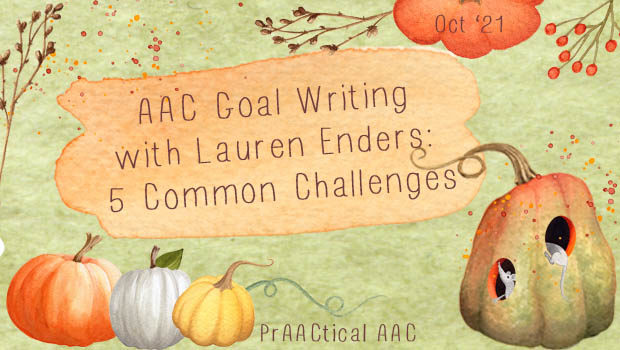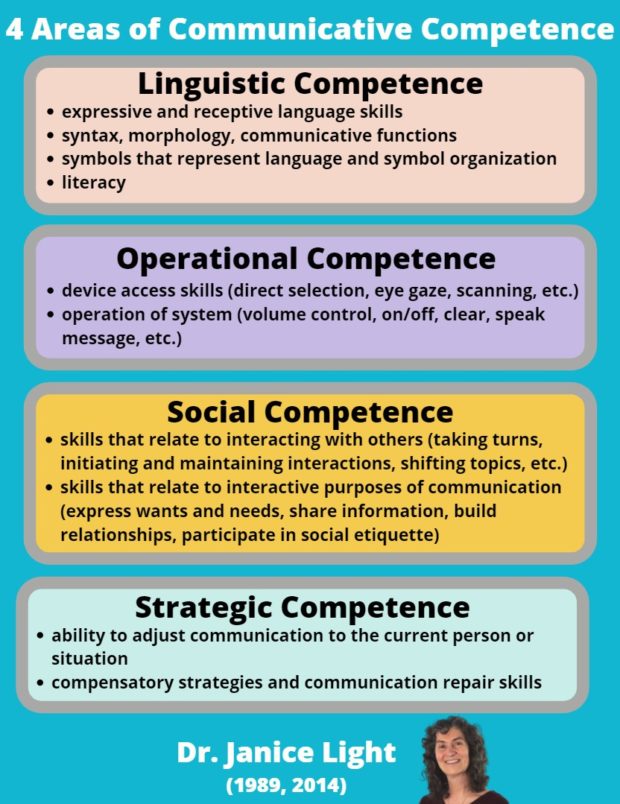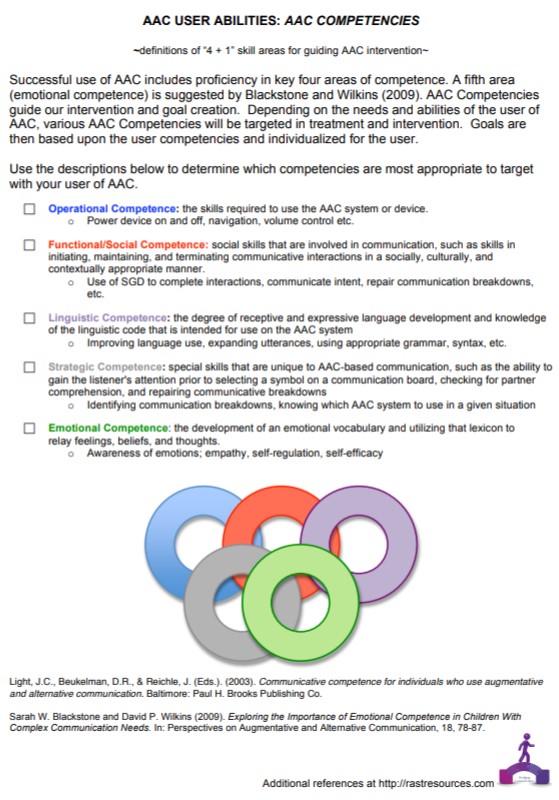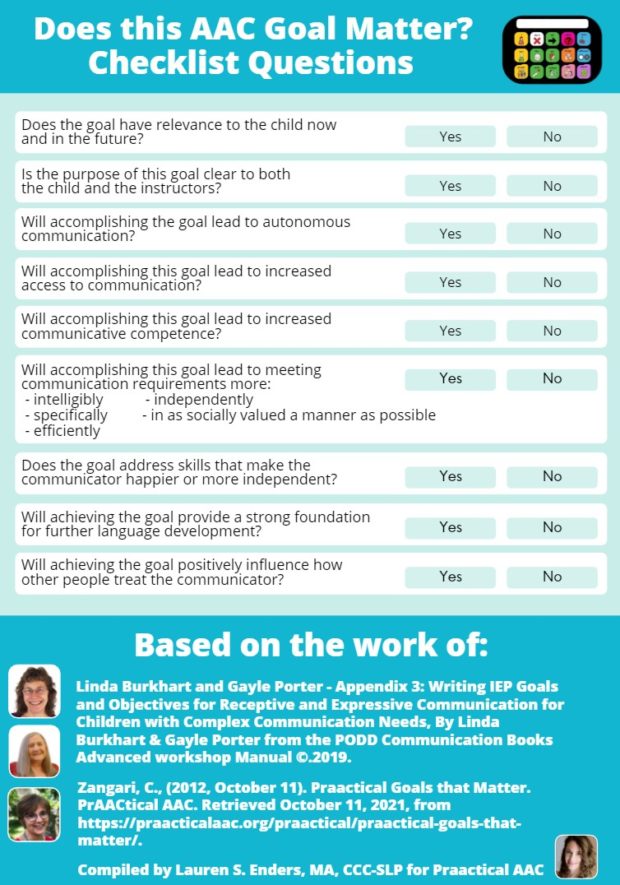AAC Goal Writing with Lauren Enders: 5 Common Challenges

 Goal writing is a challenging topic even for veteran AAC service providers. Today, we continue the AAC Goal Writing series guest authored by AAC and AT expert, Lauren Enders, who works as an AAC/AT Consultant for Bucks County Intermediate Unit in eastern Pennsylvania. A frequent presenter at local, regional, and national conferences, Lauren uses her knowledge to support families and professionals alike. In this post, she provides suggestions for addressing some of the most common challenges in writing AAC goals and objectives.
Goal writing is a challenging topic even for veteran AAC service providers. Today, we continue the AAC Goal Writing series guest authored by AAC and AT expert, Lauren Enders, who works as an AAC/AT Consultant for Bucks County Intermediate Unit in eastern Pennsylvania. A frequent presenter at local, regional, and national conferences, Lauren uses her knowledge to support families and professionals alike. In this post, she provides suggestions for addressing some of the most common challenges in writing AAC goals and objectives.
:::::::::::::::::::::::::::::::::::::::::::::::::::::::::::::::::::::::::::::::::::::::::::::::
FIVE COMMON AAC GOAL WRITING CHALLENGES
In the inaugural post of this series, you learned that if you feel intimidated by the process of writing goals and objectives for AAC learners, you are not alone. AAC goal writing can be intimidating. The good news is that with guidance, resources, tools, and practice, AAC goal writing gets easier. In this post, we’ll examine common AAC goal writing challenges and begin our discussion of how we can overcome those challenges.
Determining Which Skill Areas to Target
In my role as speech-language pathologist working as a school-based AAC consultant, I find that one of the most common causes of AAC goal writing anxiety among therapists and teachers is identifying which AAC skill areas to target. We are all aware that there are many skills that must be learned before an AAC user can become a competent communicator. With so many potential areas to target, how do we decide? I have found that one of the most effective ways to get started selecting appropriate targets for AAC learners is to use the Four Communicative Competencies initially described by Dr. Janice Light (Light et al., 1989) and updated by Light & McNaughton (2014). Below is a general breakdown of the skills included in each of the four competency areas.
- Linguistic Competence:
- expressive and receptive language skills (Don’t forget about receptive language! I find that VERY often goals targeting receptive language skills are left out of IEPs for AAC learners.)
- syntax, morphology, communicative functions
- symbols that represent language and symbol organization
- literacy
- Operational Competence:
- device access skills (direct selection, eye gaze, scanning, etc.)
- operation of the system (volume control, on/off, clear, speak message, etc.)
- Social Competence:
- skills that relate to interacting with others (taking turns, initiating and maintaining interactions, shifting topics, etc.)
- skills that relate to interactive purposes of communication (express wants and needs, share information, build relationships, participate in social etiquette)
- Strategic Competence:
In a helpful one-page handout from their RAST Resources website, Deborah Burns-McCloskey, MA, CCC-SLP, Diane Russell, MS, CCC-SLP, Judith Lunger-Bergh, MA, CCC-SLP, and Kati Skulski, MS, CCC-SLP summarized the four communicative competencies and added a fifth competency:
- Emotional Competency: Blackstone and Wilkins (2009) described “the development of an emotional vocabulary and utilizing that lexicon to relay feelings, beliefs, and thoughts.”
Kate Ahern also adds an additional competency that is worthy of consideration in her 2014 blog post entitled Meaningful and Evidence-Based Goals – Part One AAC.
- Self-Advocacy: Kate described this “bonus” competency as “a must for alternative communicators with more complex needs” and described it as the learner identifying, expressing, and directing others to meet their needs (physical and emotional).
- Kate’s examples:
- asking to “stop” before he or she becomes frustrated
- sharing a physical or emotional need
- Saying something like, “Don’t talk to me like a baby” or “I’m not stupid
- getting physical needs met, such as asking to eat, drink or take a break
- asking for an explanation, giving detailed instructions to meet care needs
- reporting neglect and abuse (something happened on the bus, I was scared) .
- Kate’s examples:
By breaking skill areas down into these competencies, it’s much easier to identify areas of need and ensure that important skill areas are not being overlooked. Later in this series, we will examine tools that help identify where students fall in each of the competency areas.
Making Sure the Goals We Write Matter
In addition to questions about which skill areas to target, I am often asked how to write goals that are most meaningful for AAC learners. I find that running through a series of questions can be helpful in determining if a potential target skill is likely to have an impact on an AAC learner. In their excellent handout, Writing IEP Goals and Objectives for Receptive and Expressive Communication for Children with Complex Communication Needs, By Linda Burkhart & Gayle Porter from the PODD Communication Books Advanced workshop Manual ©.2019, Linda and Gayle suggest that we ask ourselves:
- Does the goal have relevance to the child now and in the future?
- Is the purpose of this goal clear to both:
-
- the child?
- the instructors?
3. Will accomplishing this goal lead to:
-
- Autonomous communication?
- Increased access to communication?
- Increased Communicative Competence?
- Meeting communication requirements more:
- Intelligibly
- Specifically
- Efficiently
- Independently
- In as socially valued a manner as possible
Dr. Carole Zangari also shared qualities of goals that matter in the October 11, 2012 Praactical AAC post PrAACtical Goals that Matter, The following questions could be added to the questions above:
- Does the goal address skills that make the communicator happier or more independent?
- Does the goal teach things that enable the communicator to be a more efficient learner?
- Will achieving the goal provide a strong foundation for further language development?
- Will achieving the goal positively influence how other people treat the communicator?
I have combined these questions into a one-page checklist that you might find helpful when selecting skills to target with your AAC learners.
Assessing Where a Student’s Skills Currently Lie & Determining Developmentally Appropriate Next Steps
Many of the professionals I support in the schools ask me for guidance in how they can assess their student’s current skill level across AAC-related tasks. Thankfully, there are a variety of tools we can use that make that task easier, several of which are organized within the four primary AAC competencies. Stay tuned for the upcoming post reviewing available tools that can be used to guide these decisions!
Crafting Goals That Are Measurable
(& clear enough to be followed by anyone implementing the IEP)
Yet another AAC goal writing task that many find challenging is crafting goals that are both measurable and transparent to all team members (including families). Additionally, it is not uncommon for goals to be written in a manner that is too broad or targets too many skills at once. As we continue this series, we will:
- examine some of the challenges with using commonly used measurement
criteria for AAC goals - explore ideas for ways to write measurement criteria that makes sense for AAC
learners - review sample goals from each of the competence areas
Helping the Team Implement AAC Instruction with Consistency & Fidelity Throughout the Day
I often receive messages from invested team members who are eager for suggestions on how they can write goals in a way that will help ensure that AAC is implemented ALL DAY using best practices (such as aided language stimulation, reduced demands, wait time, etc.). Embedding essential strategies into the goal (e.g., Given consistent aided language input, the student will; In the context of preferred activities and trained communication partners, Student will…) can be helpful in getting the whole team on board. I will be sure to include examples of embedded strategies in the sample goals provided!
References
Ahern, K. (2014, April 8). Meaningful and evidence-based goals – part one AAC. Retrieved October 11, 2021, from http://teachinglearnerswithmultipleneeds.blogspot.com/2014/04/meaningful-and-evidence-based-goals.html.
Blackstone, S. W. and Wilkins, D.P. (2009). Exploring the Importance of Emotional Competence in Children with Complex Communication Needs. In: Perspectives on Augmentative and Alternative Communication, 18, 78-87.
Burkhart, L, and Porter, G. (2019). Writing IEP Goals and Objectives for Receptive and Expressive Communication for Children with Complex Communication Needs. From the PODD Communication Books Advanced Workshop Manual.
Light, J. (1989). Toward a Definition of Communicative Competence for Individuals Using Augmentative and Alternative Communication Systems. Augmentative and Alternative Communication, 5, 137–144.
Light, J.C., Beukelman, D.R., & Reichle, J. (Eds.). (2003). Communicative Competence for Individuals who Use Augmentative and Alternative communication. Baltimore: Paul H. Brooks Publishing Co. Sarah W.
Light, Janice & McNaughton, David. (2014). Communicative Competence for Individuals who require Augmentative and Alternative Communication: A New Definition for a New Era of Communication? Augmentative and Alternative Communication. 30. 1-18. 10.3109/07434618.2014.885080.
Zangari, C., (2012, October 11). Praactical Goals that Matter. PrAACtical AAC. Retrieved October 11, 2021, from https://praacticalaac.org/praactical/praactical-goals-that-matter/.
:::::::::::::::::::::::::::::::::::::::::::::::::::::::::::::::::::::::::::::::::::::::::::::::
You can learn more from Lauren here.
Lauren S. Enders, MA, CCC-SLP is a licensed and ASHA certified Speech-Language Pathologist working as a school-based Augmentative and Alternative Communication and Assistive Technology (AT) Consultant for Bucks County Intermediate Unit in Bucks County, Pennsylvania. She has had a passion for using AAC and other forms of assistive technology to support students with complex communication needs and complex bodies since she began her career in 1995. Lauren presents regularly at national conferences including Closing the Gap, ATIA, and ASHA as well as more intimate conferences, speaking engagements, and webinars. She has shared her knowledge via blog posts on PrAACticalAAC.org and USSAAC’s Speak Up blog as well as articles published in the ASHA Leader and Closing the Gap Solutions Magazines. Lauren enjoys sharing AAC and AT-related resources and networking with others in the field via Facebook, Pinterest, Twitter, Instagram, and Scoop.It.
Filed under: Featured Posts, PrAACtical Thinking
This post was written by Carole Zangari



